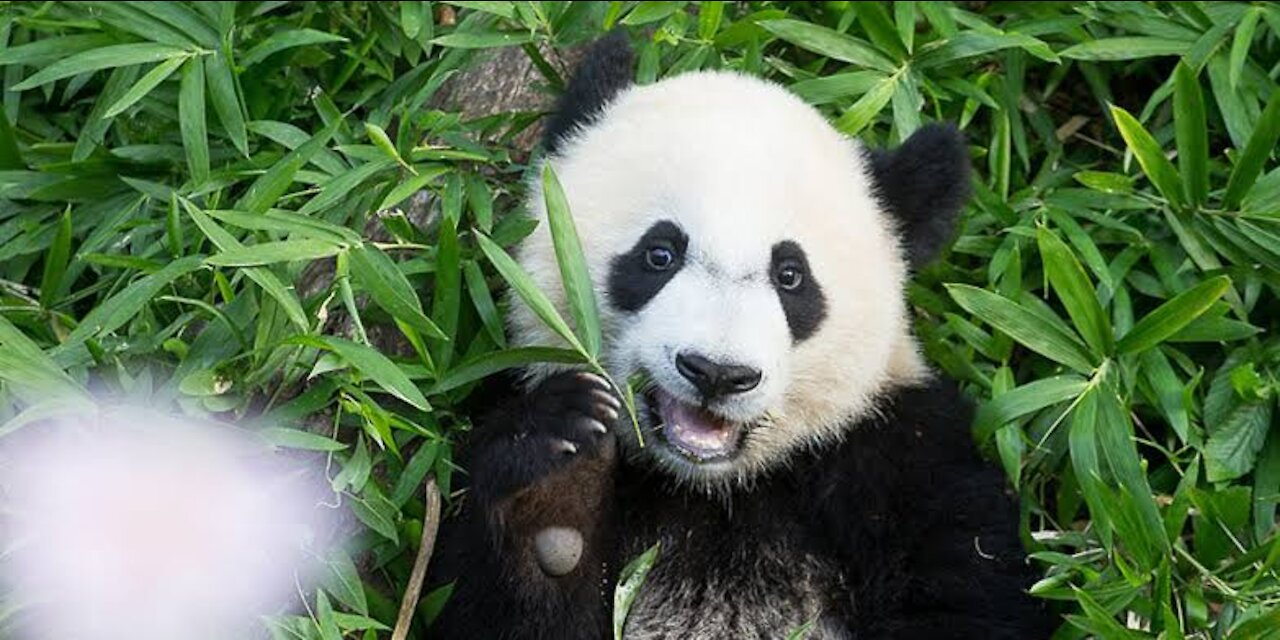Premium Only Content

Cute Panda Footage
1. THEY HAVE GREAT CAMOUFLAGE FOR THEIR ENVIRONMENT
The giant panda's distinct black-and-white markings have two functions: camouflage and communication. Most of the panda - its face, neck, belly, rump - is white to help it hide in snowy habitats. The arms and legs are black, helping it to hide in shade.
2. THEIR EYES ARE DIFFERENT TO NORMAL BEARS
Like domestic cats, giant pandas have vertical slits for pupils.
Giant panda © WWF China / Yong Yange© WWF China / Yong Yange
3. CUBS ARE WELL PROTECTED IN THEIR FIRST MONTH
Mother pandas keep contact with their cub nearly 100% of the time during their first month - with the cub resting on her front and remaining covered by her paw, arm or head.
Juvenile giant panda climbing© naturepl.com / Pete Oxford / WWF
4. COURAGEOUS CUBS!
At 5 months old, giant pandas learn how to climb - sometimes practicing by climbing on their mum.
Portrait of a giant panda ( Ailuropoda melanoleuca ). Bifengxia Panda Base, Sichuan. China © Richard Barrett / WWF-UK© Richard Barrett / WWF-UK
5. A HELPING HAND
They have an extended wrist bone that they use like a thumb to help them grip food.
Giant panda eating Bamboo© Sharon Fisher
6. THEY SPEND A LOT OF THEIR DAY EATING
Giant pandas spend 10-16 hours a day feeding, mainly on bamboo.
Giant panda eating bamboo© Richard Barrett / WWF-UK
7. BAMBOO IS CRITICAL TO THEIR DIET
Pandas need at least 2 different bamboo species in their range to avoid starvation
Giant Panda Zhen Zhen visiting the Panda Research Camp Wuyipang, China© George B. Schaller / WWF
8. BUT THEY DO OCCASIONALLY EAT SOMETHING OTHER THAN BAMBOO
Although pandas are 99% vegetarian their digestive system is typical of a carnivore. For the 1% of their diet that isn't bamboo, pandas eat eggs, small animals, carrion, and forage in farmland for pumpkin, kidney beans, wheat and domestic pig food.
Wild Giant Panda scenting a tree© Anzihe Nature Reserve/WWF China
9. PANDAS SOMETIMES DO HANDSTANDS WHEN THEY WEE!
Sometimes, to mark their scent, panda's climb a tree backwards with their hindfeet until they're in a full handstand upside down - enabling them to leave their scent higher up.
Giant panda in tree, Wolong Nature Reserve, China.© Bernard De Wetter / WWF
10. THEY LIKE TO KEEP IT REGULAR
On average, pandas poo 40 times a day.
-
 7:43:34
7:43:34
SpartakusLIVE
9 hours agoDuos w/ GloryJean on VERDANSK || #1 Most EATING Streamer
62.7K2 -
 7:25:28
7:25:28
Spartan (Pro Halo esports Player)
10 hours agoSdcrims no comms, then College match
56.4K -
 34:43
34:43
Stephen Gardner
8 hours ago🚨Trump Lawyer makes TWO HUGE ANNOUNCEMENTS | Benny Johnson
88.2K65 -
 2:17:31
2:17:31
Robert Gouveia
9 hours agoJudge BLOCKS Proof-of-Citizenship! Trump BACK to Supreme Court! Deportee Discovery STAYED!
79.6K35 -
 7:04:37
7:04:37
MyronGainesX
23 hours ago $22.94 earnedCollege Debate Reaction, Jordan Peterson Sells Out, Shannon Sharpe Shakedown!
118K35 -
 2:01:49
2:01:49
Joker Effect
5 hours agoWE ARE IN THE WILDWEST! Frontier Legends is crazy!
29.3K -
 3:54:43
3:54:43
FrizzleMcDizzle
7 hours agoELDEN RING and I'm officially a creator on RUMBLE
38.3K1 -
 1:33:35
1:33:35
theoriginalmarkz
8 hours agoEvening News with MarkZ, joined by Jonathan Otto. 04/24/2025
84.7K6 -
 8:02:49
8:02:49
Lilpaul112
8 hours agoSolos On the Island / Repo Time With the Brrrap Pack Gang!
28.1K1 -
 3:56:48
3:56:48
GrimmHollywood
8 hours ago🔴LIVE • GRIMM HOLLYWOOD • REPO with the BRRRAP PACK • THEIR FIRST TIME PLAYING •
27K